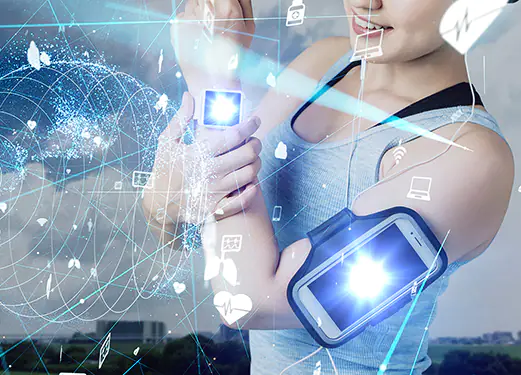
The healthcare ecosystem is changing rapidly. One major catalyst for this change has been the adoption of IoT technology that has rendered significant impact on patient outcomes and operations.
Factors like the pandemic of 2020, subsequent shortage of healthcare workers, aging population, need for connected care, necessity for bringing down the healthcare cost, demand for improving the quality of care, and many more, have given a big push to IoT adoption in healthcare.
Parallelly, sharp increase in the adoption of IoT devices by different stakeholders of the healthcare system has certainly accelerated digital transformation. Some of the quick benefits of digitization include the ability to serve more patients, accessibility to accurate and real time patient health data, home care monitoring, increased patient engagement, and prediction of emergencies, to name a few.
Riding the Digitization Wave
While the benefits of riding the digital wave are many, there are also some inherent challenges that Telehealth and Remote Patient Monitoring companies face. Some of these include:
- Management of hundreds of thousands of devices (connect, monitor, and manage)
- Issues surrounding data security and privacy
- Seamless integration between different devices and healthcare systems
- Different type of devices (along with their platforms and requisites)
- Limitations with respect to scale
- Realtime data processing
Overcoming the above impediments requires a substantial investment of time and resources. While on the one hand, companies face challenges in terms of infrastructure, engineering and maintenance cost, on the other side managing the massive data that gets generated from these devices is also equally taxing. So, how do product companies resolve these issues so that they have a quick fix that works seamlessly with their products while requiring minimal efforts and investments?
The conventional approach would be to build a custom solution. Primary reasons to lean towards this option are:
- Having good amount of control over the features
- Customizing the design to specific needs and wants
Not everyone may choose to go this way as there is an attractive alternative to this. The option is that of a quick solution that would:
- Reduce the time to market and,
- Save on long-drawn engineering and operations
The good news is that some of the major cloud providers have come to the rescue of such product companies with their IoT specific offerings (for healthcare as well as for other industries). The biggest advantage that big players like Microsoft or AWS or Salesforce offer is an end-to-end package. This comes as a big relief for product owners and helps companies to set their wheels in motion.
This blog intends to give you a quick overview of what each of these cloud providers broadly offers.
Microsoft Azure for Remote Patient Monitoring
Microsoft has rolled this out under their Azure set of offerings. In this specially designed package for Remote Patient Monitoring, they have come up with an end-to-end solution for product companies seeking not only a seamless IoT device integration but also scale, data security, and AI capabilities.
![]()
Azure IoT Hub can connect virtually any device through its cloud hosted solution. It offers features like per-device authentication, built-in device management, and scaled provisioning. Also, the device builders can get IoT plug and play certification for their devices and publish them in the Azure-certified device catalog.
Azure provides different ways for device management and connectivity like a platform as a service or through a managed app platform. Azure IoT Connector for FHIR leverages HL7’s Fast Healthcare Interoperability Resources spec to enable secure and private interoperability among IoMT (Internet of Medical Things) devices and EHRs (Electronic Health Records).
In short, Azure IoT offers a trusted technology platform to improve patient outcomes, streamline clinical operations, and optimize your healthcare manufacturing and supply chain with seamless, smart, and highly secure IoT technology. This is a definite win-win for healthcare providers, patients, and device manufacturers.
Amazon Web Services (AWS) IoT for Remote Patient Monitoring
AWS has AWS IoT services that health IT and medical device manufacturers can easily use. Customers can easily get started using AWS IoT 1-Click with supported devices. AWS IoT 1-Click is a service that enables simple devices to trigger AWS Lambda functions that can execute an action. Like Microsoft, with AWS device manufacturers can easily onboard (register) devices on to AWS IoT 1-Click which can later be used by companies as a plug-and-play device.

Important AWS components that help build remote monitoring capability:
- AWS IoT Core – for connected devices to interact with cloud applications and other devices
- AWS IoT Device Defender – to monitor and audit IoT configurations
- AWS IoT Device Management – to register, organize, monitor, and remotely manage IoT devices
- AWS IoT Analytics – to run sophisticated analytics on the massive volume of IoT data
- AWS IoT SiteWise – to collect, organize, and analyze industrial data at scale
- AWS IoT Events – to detect and respond to events from a large number of IoT sensors and applications
- AWS IoT Things Graph – to connect different devices and cloud services to build IoT applications.
Salesforce Health Cloud and IoT Cloud for Remote Patient Monitoring
To address the need for Healthcare and IoT, Salesforce offers Salesforce Health Cloud and Salesforce IoT Cloud. Salesforce Health Cloud together with Salesforce IoT Cloud caters to the need for remote patient monitoring. It provides users with a platform for storing and processing data from connected devices.
Salesforce Health Cloud is a patient and member relationship management platform that provides a complete view of the patient, intelligent care collaboration, and a connected patient engagement experience.
The Salesforce IoT Cloud is powered by their proprietary real-time event processing engine Thunder that handles massive amounts of data from connected assets. The Salesforce IoT Cloud is a platform for storing and processing IoT data. It gathers data from different sources and triggers actions for real-time responses. In addition to this, Salesforce also has IoT Explorer Edition which is an interface for building low-code apps on top of IoT data.
Quick Capability Building
In this post, I have briefly touched upon the specialized Remote Patient Monitoring offerings of some of the major cloud providers. These offerings are recommended as one-stop-shop for healthcare product companies to build applications quickly.
For additional perspectives you may also read:
- Patient Engagement: An Imperative in Healthcare
- Building Technical Capabilities to Augment Remote Patient Engagement
Harbinger has helped several healthcare product companies to quickly build Remote Patient Monitoring capabilities using these cloud platforms as well as using custom solutions. Write to me at pankaj@harbingergroup.com to discuss your need or even to understand our expertise and experience in this area.
Let’s work together to make healthcare more affordable to all.






